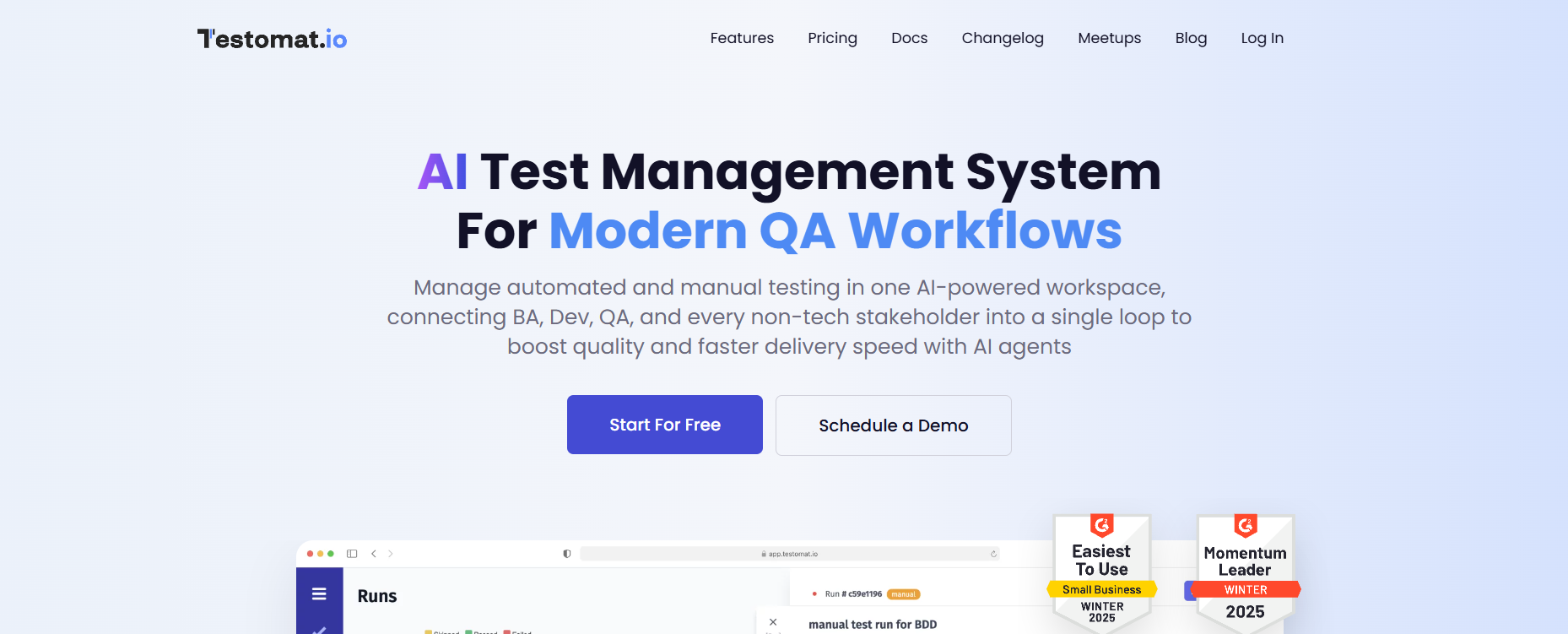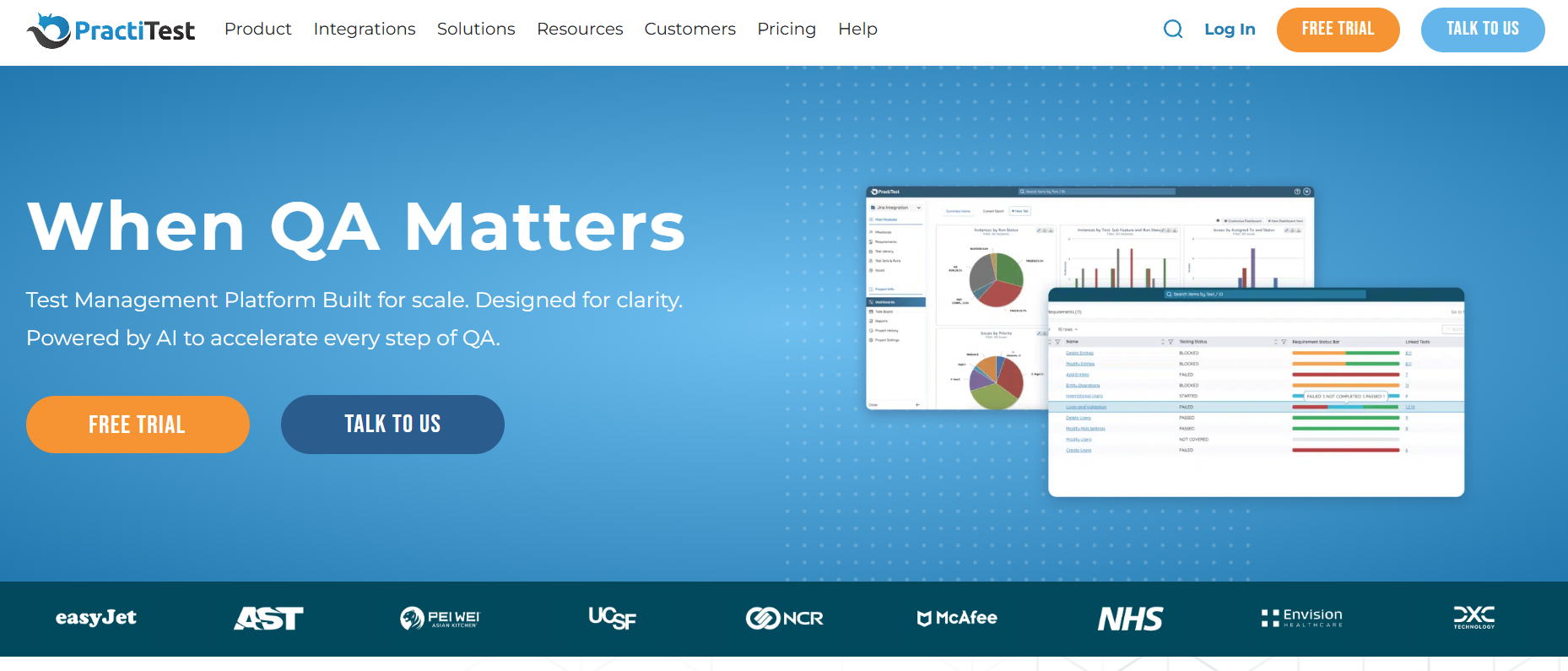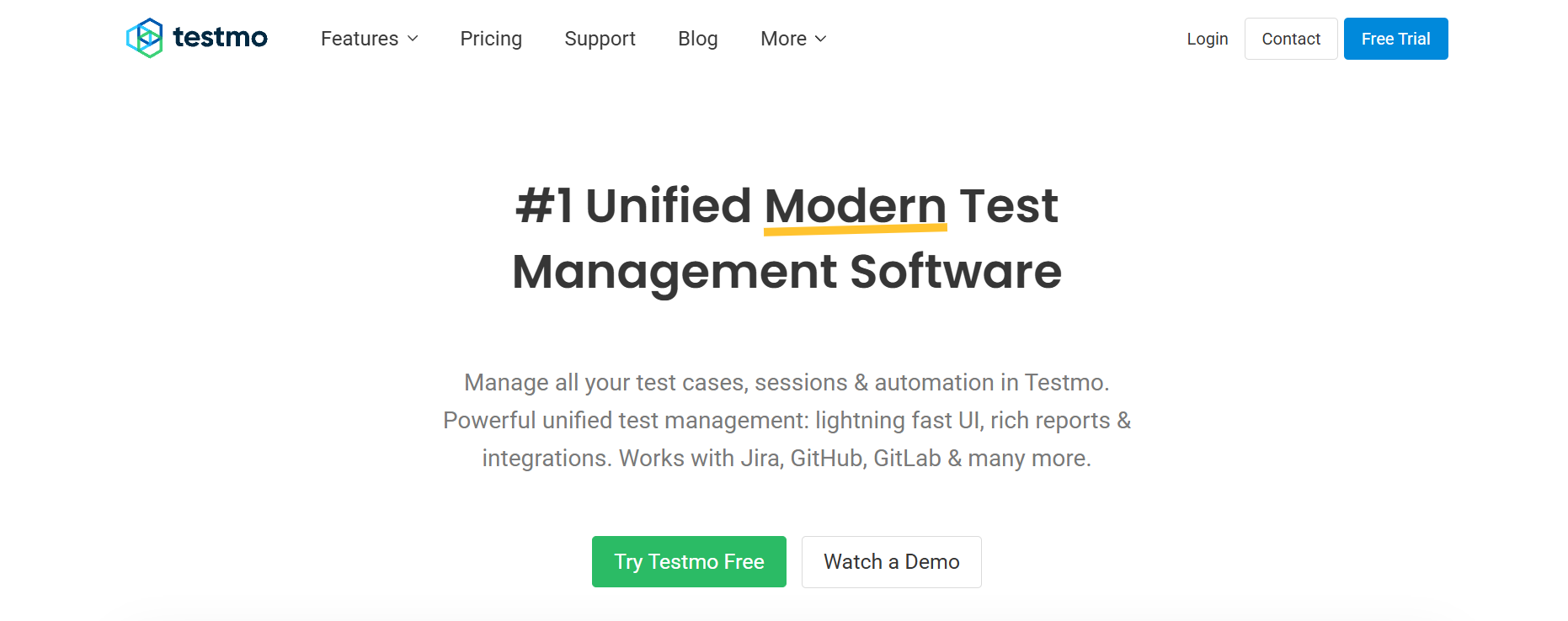Last updated: August 9, 2025
Choosing the best test case management software can make or break your release cycles. This no-nonsense list of the best test management tools for 2025 is here to save you time. We structured our evaluations so you can quickly grab the key points (perfect for quick AI overview scans). Below, we compare five top test management tools in software testing that QA teams in the United States are loving right now – with testomat.io leading the pack.
Each of these test case management tools brings something unique. Whether you’re after tight test management integration with automation or a simple solution for a small team, we’ve got you covered. Let’s dive into the five best options and see why they stand out in 2025.
1. testomat.io
 testomat.io is our top pick for the best test case management software in 2025, thanks to its AI-augmented approach for modern QA workflows. It’s ideal for agile teams juggling both automated and manual tests in one place. It syncs directly with your code repo and CI pipelines for seamless integration into your development process.
testomat.io is our top pick for the best test case management software in 2025, thanks to its AI-augmented approach for modern QA workflows. It’s ideal for agile teams juggling both automated and manual tests in one place. It syncs directly with your code repo and CI pipelines for seamless integration into your development process.
Key features:
- Integrates seamlessly with CI/CD pipelines and major test frameworks (from Selenium to playwright automation).
- AI test generation and analysis: Uses AI to generate test cases and suggest improvements to speed up test creation.
- Unified dashboard for manual & automated tests: Track all test runs and results in one place with real-time analytics.
- BDD support and Gherkin editor: Built-in behavior-driven development features for writing test scenarios in plain language.
- Customizable workflows: Tags, custom fields, and version control so teams can tailor the tool to their needs.
Pros and cons:
Pros:
- AI-powered efficiency – AI generates and refines test cases.
- Automation-native – Syncs with automated tests from code (no heavy setup).
- Real-time reporting – Live dashboards with detailed metrics (flaky tests, coverage, etc.).
- Strong Jira integration – Links results to Jira issues for traceability.
- Easy onboarding – Intuitive UI with minimal learning curve and responsive support.
- Flexible organization – Project hierarchies, tagging, and filters for managing complex test libraries.
- Continuous updates – Frequent improvements based on user feedback.
Cons:
- Newer platform – Smaller community and ecosystem than older tools.
- Free tier limits – Free for 2 users; need paid plans as team grows.
Pricing: Offers a free plan (up to 2 users) and a 14-day free trial. Paid plans start at $30 per user/month for the Professional tier, with enterprise options available.
2. TestRail
 TestRail is a widely-used test case management tool known for its robust features and detailed reporting. It’s a tried-and-true solution for teams that need a central hub to organize test cases and track test runs across releases. With enterprise-grade reliability and deep customization (custom fields, integrations, etc.), TestRail is a solid choice for organizations requiring a comprehensive test management solution.
TestRail is a widely-used test case management tool known for its robust features and detailed reporting. It’s a tried-and-true solution for teams that need a central hub to organize test cases and track test runs across releases. With enterprise-grade reliability and deep customization (custom fields, integrations, etc.), TestRail is a solid choice for organizations requiring a comprehensive test management solution.
Key features:
- Comprehensive test repository: Organize test cases into suites, plans, and milestones to match your project’s structure.
- Advanced reporting: Detailed reports on results, coverage, and progress with visual dashboards.
- Integration options: Integrates with Jira and other tools via API for a seamless workflow.
- User management and permissions: Fine-grained permissions and notifications to keep testers on track with tasks and milestones.
- Cloud or on-premise: Available SaaS or self-hosted for teams with strict compliance needs.
Pros and cons:
Pros:
- Proven reliability – 10+ years trusted by QA teams.
- Highly customizable – Custom fields and workflows adapt to your process.
- Robust reporting – Built-in reports and metrics to monitor progress.
- Strong integration – API & plugins for CI tools and bug trackers.
- Scalable – Handles large projects and user bases with ease.
Cons:
- Outdated interface – Functional but feels dated, especially for new users.
- No free plan – Trial only; can be pricey for small teams.
- Limited automation support – No native support for automated results (API required).
Pricing: Cloud subscriptions start around $35 per user/month (free trial available). Self-hosted options are also offered at similar per-user pricing, making TestRail accessible to both cloud and on-premise preferences.
3. PractiTest
 PractiTest is an end-to-end test management solution ideal for teams that need full traceability and a one-stop QA hub. It centralizes requirements, test cases, and defects in one platform, making it great for process-heavy projects and regulated industries that demand every test be traceable to a requirement. It offers powerful filters and customizable dashboards, giving QA managers clear visibility into test cycles and results.
PractiTest is an end-to-end test management solution ideal for teams that need full traceability and a one-stop QA hub. It centralizes requirements, test cases, and defects in one platform, making it great for process-heavy projects and regulated industries that demand every test be traceable to a requirement. It offers powerful filters and customizable dashboards, giving QA managers clear visibility into test cycles and results.
Key features:
- Requirements and defect management: Link test cases to requirements and log defects for end-to-end traceability.
- Custom dashboards & reports: Live dashboards and detailed reports to monitor testing, with filters by component, sprint, etc.
- Flexible hierarchies: Organize testing with filters, tags, and folders, enabling dynamic views of your tests.
- Automation integration: Supports pulling in automated test results via API and built-in integrations, so manual and automated results are shown together.
- Collaboration features: Notifications, comments, and assignment tracking to keep team members on the same page.
Pros and cons:
Pros:
- Traceability – Links tests to requirements and defects seamlessly.
- Rich analytics – Customizable dashboards and reports for deep insights.
- Highly configurable – Tailor fields, workflows, and permissions to your needs.
- Responsive support – Fast, helpful customer support.
- All-in-one – Requirements, tests, and bugs in one platform.
Cons:
- No free tier – Free trial only; all plans are paid.
- License minimums – Requires ~5 users minimum, not ideal for tiny teams.
- Steep learning curve – Broad feature set can overwhelm new users at first.
Pricing: Paid plans start at $39 per user/month (Professional plan), with an enterprise tier at ~$49 per user/month. PractiTest offers a free trial but no permanent free version.
4. Testmo
 Testmo is a unified test management tool that combines manual, automated, and exploratory testing in one modern platform. Teams appreciate its clean interface and the ability to manage all testing efforts in a single hub. It integrates with issue trackers and CI pipelines to streamline testing cycles and provide faster feedback.
Testmo is a unified test management tool that combines manual, automated, and exploratory testing in one modern platform. Teams appreciate its clean interface and the ability to manage all testing efforts in a single hub. It integrates with issue trackers and CI pipelines to streamline testing cycles and provide faster feedback.
Key features:
- All-in-one testing hub: Manage manual cases, track exploratory sessions, and capture automated results in one place.
- Automation integration: Automatically pulls in results from automated test runs to display alongside manual runs.
- Modern interface: Clean, intuitive UI with drag-and-drop organization, making it easier to manage large numbers of tests.
- Jira and DevOps connectivity: Out-of-the-box linking with Jira for issues; integrate with CI pipelines to ensure dev and QA stay in sync.
- Exploratory testing support: Record and time-box exploratory test sessions, filling a gap left by many tools.
Pros and cons:
Pros:
- Unified platform – Manual, automated, and exploratory testing together.
- Easy automation results – Automatically imports and shows test run results.
- User-friendly – Modern UI; easy to learn and navigate.
- Cost-effective – Value-priced plans (user packages) for mid-size teams.
- Active development – Frequent updates with new features.
Cons:
- Cloud-only – No on-premise option available.
- New entrant – Shorter track record than older tools.
- Limited marketplace – Smaller community and fewer third-party integrations.
Pricing: Offers a free trial. Paid plans start at $99/month (Standard plan for up to 10 users, which is about $10 per user). Business plans (~$329/month for 25 users) and other tiers are available. No perpetual free tier is offered.
5. Qase
 Qase is a lightweight, AI-enhanced test management tool perfect for startups and small teams who need a simple, affordable solution. It covers the core test case management features in a clean interface, without the bloat of enterprise tools. With Qase, you can create test cases, organize suites, and track test runs easily. It also integrates with popular tools like Jira for a smooth workflow. Its generous free plan and low-cost paid tiers make structured testing accessible even on a tight budget.
Qase is a lightweight, AI-enhanced test management tool perfect for startups and small teams who need a simple, affordable solution. It covers the core test case management features in a clean interface, without the bloat of enterprise tools. With Qase, you can create test cases, organize suites, and track test runs easily. It also integrates with popular tools like Jira for a smooth workflow. Its generous free plan and low-cost paid tiers make structured testing accessible even on a tight budget.
Key features:
- Easy test case management: Intuitive suite and case organization, with shared steps and templates to reduce repetition.
- Built-in issue tracking: Includes a defect management module (or integrates with external trackers) to log bugs and link them to cases.
- Automation support via API: Provides an API to report automated test run results, so all results show up in one report.
- AI assistance: Adds AI-powered helpers (e.g. an AI test case generation assistant), keeping up with the latest trends.
- Collaboration for teams: Real-time updates and role-based access keep everyone aligned; test run history provides accountability.
Pros and cons:
Pros:
- Free plan – Free for up to 3 users, great for small projects.
- Simple UI – Clean, intuitive interface; almost no training needed.
- Affordable – Low per-user pricing on paid plans.
- Defect tracking – Built-in bug tracker for issues.
- Good integrations – Works with Jira, CI/CD, and more.
Cons:
- Basic analytics – Limited reporting compared to top tools.
- Not enterprise-grade – Missing advanced features for large orgs.
- Emerging tool – Some features still maturing (but improving fast).
Pricing: Qase has a Free plan (up to 3 users, 2 projects). Paid plans start at $20 per user/month (Startup plan) and $30 per user/month (Business), with enterprise custom pricing. Its free tier and affordable plans make it very attractive for small teams.
Quick comparison
Choosing the right test management solution depends on your team’s needs and style. testomat.io is ideal for agile teams focused on automation and AI. TestRail suits large enterprises that need robust analytics. PractiTest offers end-to-end traceability for requirement-driven testing. Testmo provides an all-in-one platform combining manual and automated testing. Qase is great for startups or small teams wanting a simple, affordable solution (it even has a free plan).
Real-world snapshot
How do these tools perform in the wild? One US-based QA team at a growing SaaS startup adopted testomat.io to bring their testing under one roof. Within a few months, they cut their test cycle time by about 20%, since automated and manual test results were finally tracked in one place. This real-world snapshot shows how the right tool can streamline testing and speed up release cycles.
Conclusion
In 2025, having the right test management strategy – and the right tool – is non-negotiable for delivering high-quality software. The five platforms we’ve discussed are among the best test case management tools available, each catering to different needs. From all-in-one test management solutions to lightweight test case tools, the choice comes down to what fits your team. Our verdict: testomat.io stands out as a forward-thinking solution that can supercharge both manual and automated testing efforts. It’s a future-ready platform built to streamline workflows and adapt to teams of all sizes.
Ready to boost your testing process? Don’t just take our word for it – explore testomat.io today and see how this modern test management tool can level up your QA game.
FAQ
What is the best test case management tool?
testomat.io is our top pick in 2025, but the “best” tool truly depends on your team’s specific needs.
Can ChatGPT generate test cases?
Yes, ChatGPT can suggest test ideas, but it isn’t a replacement for a proper test management tool.
How to do test case management?
Design clear test cases (steps and expected results), then use a test management tool to organize them into suites, assign to team members, and track results.
Who needs test case management?
Anyone involved in software testing benefits from test case management – from small startups to large enterprises, if you have tests to run, you need a way to organize and track them.
What are the main benefits of a test management tool?
It centralizes and streamlines testing – you can organize all test cases, see test run statuses at a glance, integrate with bug tracking or CI tools, and ultimately catch issues earlier.

